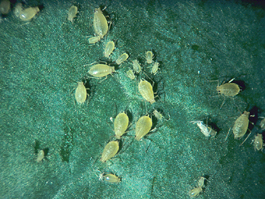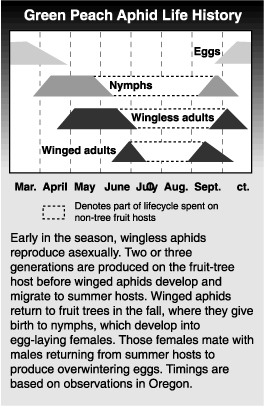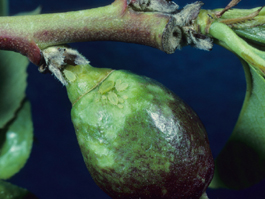by Lynn Long and Helmut Riedl, originally published 1993
Myzus persicae (Sulzer) (Homoptera: Aphididae)

A native of Europe, the green peach aphid is now widely distributed across the United States and Canada. Though a common pest of stone fruits, primarily peaches, it is not usually considered a serious pest, except on nectarine. It is more destructive on vegetable crops, which are a summer host, because it is a vector of several important diseases.
Hosts
The green peach aphid attacks primarily peach and nectarine. In summer it moves to other hosts, which include a wide range of weeds and commercial vegetable crops. Green peach aphid is one of the more important aphid pests of potato.
Life stages
Egg
The egg is shiny black and oval, similar to that of the apple aphid.
Nymph
The nymph is slender and a pinkish color at first. As it develops, it becomes a yellowish-green color with three indefinite darker green stripes on the back of the abdomen.
Adult
The wingless adult resembles the nymph but is larger. The winged adult has a black head and thorax and a yellowish-green abdomen with a large dark brown patch on the top of the abdomen.
Life history
 Overwintering eggs are laid in bud axils and bark crevices on twigs. They hatch just before bud break. The nymphs develop into wingless females, which produce young without mating. The aphids feed on the underside of the leaves. As the population increases, the leaves curl. After 2 or 3 generations, winged forms are produced, which migrate to summer hosts, where several generations are produced. In the fall, winged aphids return to peach and other stone fruits and give birth to nymphs. These develop into egg-laying females, which mate with males returning from summer host plants. They lay eggs that overwinter.
Overwintering eggs are laid in bud axils and bark crevices on twigs. They hatch just before bud break. The nymphs develop into wingless females, which produce young without mating. The aphids feed on the underside of the leaves. As the population increases, the leaves curl. After 2 or 3 generations, winged forms are produced, which migrate to summer hosts, where several generations are produced. In the fall, winged aphids return to peach and other stone fruits and give birth to nymphs. These develop into egg-laying females, which mate with males returning from summer host plants. They lay eggs that overwinter.
Damage
Peach crops can tolerate moderate infestations with little impact on the crop, but heavy infestations can cause serious damage. Where the aphid population is extremely heavy, leaves will become badly curled and flowers or newly formed fruit will abort. High populations can also reduce tree vigor and retard shoot growth. The most serious damage occurs on nectarine because aphids feed directly on young fruit. This feeding distorts normal growth and leaves fruit bumpy and unmarketable.

Monitoring
As most eggs hatch before bloom, begin monitoring at the delayed-dormant stage. Young aphids are easy to detect on the outside of open buds at this time. Examine several buds on 20 trees from throughout an orchard to determine the number infested by aphids. As soon as flowers open, aphids crawl inside and are more difficult to detect.
Biological control
The green peach aphid is attacked by several predators. Early season establishment of lady beetles, lacewings, syrphid flies, soldier beetles and predaceous bugs is important for successful biological control. On all crops but nectarine, natural enemies will often suppress green peach aphid populations below damaging levels. Chemical control sprays for the oriental fruit moth can be very disruptive of biological control of this aphid.
Management
Populations are suppressed by pre-bloom sprays, though resistance to many insecticides reduces the effectiveness of chemical controls. They are most susceptible just after hatching and before they have crawled into opening buds and flowers, just as buds are beginning to open. Dilute sprays, assuring good coverage, have provided good control during this period. Economic damage to peaches occurs only when populations are extremely high. However, significant losses can be sustained on nectarines even with low aphid populations, as the aphids feed directly on the fruit. After aphids have become protected by entering flowers or are concealed in curled leaves, chemical control is difficult. Postbloom sprays for the aphid or other pests can kill predators, disrupting biological control, which in many orchards can suppress populations below damaging levels. Use of mating disruption for oriental fruit moth control should help encourage a build-up of natural enemies of the green peach aphid.
References consulted
Madsen, H. F., and P. J. Proctor. 1982. Insects and mites of tree fruits in British Columbia, pp. 1-70. Ministry of Agriculture and Food, Victoria, B.C.
Newcomer, E. J. 1950. Orchard insects of the Pacific Northwest and their control, pp. 63 pp. United States Department of Agriculture, Washington, DC.
Retan, A. H., and R. Thornton. 1982. Green peach aphid control on peach trees. Washington State University, Pullman, WA.